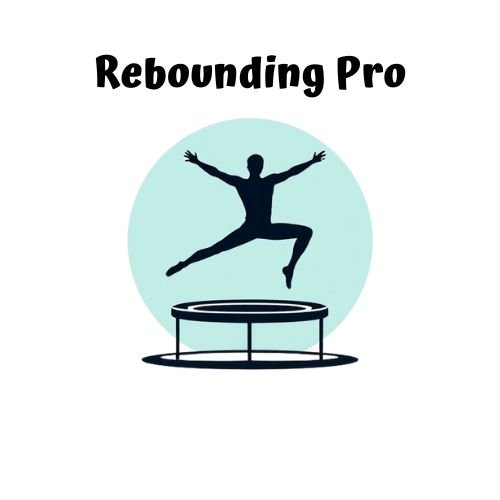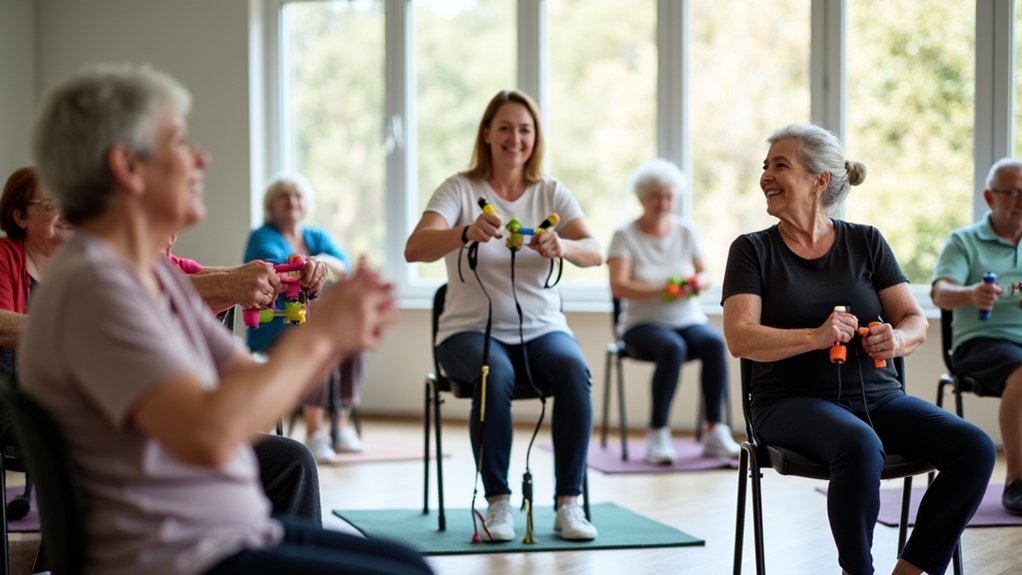HIIT workouts typically burn more calories than mini trampoline sessions due to their higher intensity and afterburn effect (EPOC), with HIIT burning 25-30% more calories than steady-state cardio. However, mini tramp workouts offer better joint protection (absorbing 80% of impact) and higher adherence rates, making them more sustainable long-term. Your best choice depends on your fitness goals, joint health, and which activity you’ll stick with consistently. The full comparison reveals surprising advantages for both approaches.
The Science Behind Calorie Burn in Exercise

While many fitness enthusiasts focus solely on the number on the scale, understanding the science of calorie burn reveals why both mini trampoline workouts and HIIT deliver impressive results. Your body weight considerably influences calories burned during exercise—heavier individuals naturally expend more energy performing the same movements.
HIIT workouts create an “afterburn effect” where your metabolism remains elevated for hours post-exercise. Research shows that rebounding on a mini tramp can burn between 250-400 calories hourly at moderate intensity, with high-intensity workouts reaching up to 12.4 calories per minute.
The beauty of both modalities lies in their efficiency. Mini trampolining absorbs over 80% of impact while providing comparable calorie burn to running, making it ideal for those seeking joint-friendly alternatives to traditional high-intensity workouts.
Understanding Mini Trampoline Workouts
Because they combine effectiveness with accessibility, mini trampoline workouts have gained popularity among fitness enthusiasts of all levels.
These rebounding sessions typically run 30-35 minutes, burning between 250-400 calories per hour depending on your intensity and weight.
What makes mini trampoline cardio workouts unique is their low-impact nature – they absorb over 80% of the impact you’d experience on hard surfaces, protecting your joints while still delivering significant fitness benefits.
You’ll engage large muscle groups through choreographed movements, high skipping, and landing jumps.
Research confirms these workouts improve your VO2max, vertical jump height, coordination, and balance.
The dynamic movements strengthen your lower body while enhancing cardiovascular endurance.
If you’re looking for an effective workout that’s gentler on your body, rebounding delivers impressive results.
What Makes HIIT Training Effective

Since its emergence in the fitness world, HIIT has revolutionized how we approach cardio training. This workout method strategically alternates intense exercise bursts with brief recovery periods, creating a powerful metabolic impact that traditional workouts can’t match.
What makes HIIT particularly effective for your fitness goals:
- Enhanced calorie burn – You’ll torch 25-30% more calories than with steady-state cardio, plus continue burning calories hours after your workout thanks to EPOC.
- Improved VO2 Max – Your aerobic capacity increases more markedly with HIIT than with moderate-intensity continuous training.
- Time efficiency – You’ll achieve greater fat reduction and cardiovascular improvements in shorter workout sessions compared to traditional cardio approaches.
Calories Burned: The Mini Tramp Test Results
Now that we comprehend HIIT’s effectiveness, let’s examine how mini trampolines measure up in the calorie-burning department.
Recent studies reveal impressive numbers: during a 10-minute session, participants burned between 65-138 calories in low-intensity rebounding and 87-146 calories during high-intensity mini trampoline workouts.
At 12.4 calories per minute, high-intensity rebounding competes directly with traditional cardio options.
What’s particularly remarkable is that you’ll achieve these results without the joint strain typical of HIIT workouts. The mini trampoline allows for sustained activity that engages large muscle groups effectively.
Over a full hour, you can expect to burn 250-400 calories on a mini trampoline, depending on your weight and intensity level—comparable to many traditional exercises while offering significant cardiovascular benefits.
HIIT Workouts and Their Metabolic Impact

High-Intensity Interval Training (HIIT) stands as a metabolic powerhouse in the fitness world, transforming how we approach calorie burning and cardiovascular conditioning.
When you incorporate HIIT workouts into your routine, you’re leveraging a scientifically proven method that can boost your metabolic rate for hours after you’ve finished exercising.
The metabolic advantages of HIIT include:
- Efficiency – HIIT burns 25-30% more calories than traditional cardio in the same timeframe
- Afterburn Effect – Your body continues calorie expenditure post-workout due to elevated oxygen consumption
- Muscle Development – The anaerobic nature builds muscle mass, increasing your resting metabolic rate
Low-Impact Benefits of Rebounding
While HIIT accelerates your metabolism with intensity, rebounding offers a completely different approach to fitness that prioritizes joint health without sacrificing results.
You’ll experience over 80% impact absorption when bouncing on a mini trampoline, dramatically reducing the stress on your knees, hips, and ankles that high-impact exercises typically cause.
What makes rebounding workouts particularly valuable is their ability to burn calories—approximately 250 to 400 per hour—while supporting your body’s natural recovery systems.
The gentle bouncing motion enhances lymphatic circulation and detoxification without taxing your joints. You can further intensify your workout by adding strength movements during your rebounding session, increasing calorie expenditure while maintaining the low-impact environment that makes this exercise accessible for all fitness levels and ideal for injury recovery.
Time Efficiency: Mini Tramp vs. HIIT
When time is at a premium, choosing the right workout can make all the difference in reaching your fitness goals efficiently.
While mini trampoline workouts burn a respectable 250-400 calories per hour, HIIT sessions typically torch 12.4-14 calories per minute, making them more efficient for time-strapped individuals.
Both workouts can be effective in short bursts:
- HIIT sessions require less time overall to achieve higher calorie burn, perfect if you’re extremely busy.
- Trampoline workouts offer moderate calorie burn with minimal joint stress, ideal for sustainable fitness.
- Rebounding HIIT combines both approaches by structuring trampoline exercises with high-intensity intervals.
If maximum calorie burn in minimal time is your priority, traditional HIIT wins, but rebounding offers a gentler approach that’s still time-efficient.
Body Composition Changes From Both Methods
The battle between mini trampoline exercises and HIIT workouts extends beyond just calorie burn to their effects on body composition. Both methods offer promising results when it comes to transforming your physique.
Studies show mini trampoline workouts effectively improve body composition through enhanced cardiovascular fitness and increased energy expenditure. You’ll experience gradual changes as your body adapts to this low-impact yet effective training style.
Bounce your way to better body composition while your cardiovascular system thrives with each gentle, effective jump.
Meanwhile, HIIT delivers more rapid body composition changes due to its higher calories burned during short, intense sessions. Research indicates HIIT participants often see faster reductions in body fat percentage compared to other training methods.
Interestingly, trampoline users showed similar fitness improvements to runners but without significant weight changes. This suggests that your results will depend on workout intensity, duration, and consistency regardless of which method you choose.
Heart Rate Comparison During Workouts
Both mini trampoline and HIIT workouts deliver impressive cardiovascular benefits, as demonstrated by the heart rate responses they produce.
When you’re bouncing on a mini tramp, your heart rate elevates to levels comparable to traditional HIIT sessions, while your joints enjoy protection from high-impact stress.
Your workout routine on either platform can produce similar cardiovascular results:
- Heart rate zones – Both modalities can maintain your heart rate at 70-85% of maximum, the sweet spot for cardiovascular improvement.
- Calories per minute – Research shows comparable calorie burn rates between intense rebounding and HIIT sessions.
- VO2max improvements – Both methods considerably enhance your body’s oxygen utilization capacity.
The key difference isn’t in the heart rate response but in how your body achieves it—rebounding provides these benefits with noticeably less joint strain.
Post-Exercise Oxygen Consumption Effects
After stepping off your exercise equipment, your body continues to burn calories through a process exercise scientists call EPOC (Excess Post-Exercise Oxygen Consumption).
This afterburn effect varies considerably between workout types, with HIIT workouts delivering superior results.
When you complete a HIIT session, your EPOC can remain elevated for up to 24 hours, burning an additional 6-15% calories above your resting metabolic rate.
This extended calorie burn gives HIIT a distinct advantage over rebounding on a mini tramp.
While rebounding does trigger some EPOC effects, they’re typically less pronounced due to the lower overall intensity.
The science is clear: if you’re looking to maximize your post-workout calorie burn, HIIT’s intense bursts of activity create a more substantial afterburn effect than the moderate intensity of rebounding.
Workout Sustainability and Adherence Rates
While HIIT workouts may deliver superior afterburn effects, success in fitness ultimately depends on consistency over time.
Mini trampoline workouts typically generate higher adherence rates than traditional HIIT routines, which directly impacts your long-term calorie-burning potential.
Research shows rebounding’s enjoyable nature creates sustainable workout habits for several reasons:
- Higher satisfaction levels – You’re more likely to stick with activities you genuinely enjoy, leading to more consistent calorie burning over time.
- Lower impact intensity – The reduced joint stress makes rebounding accessible for varied fitness levels, encouraging regular participation.
- Community atmosphere – Structured mini tramp classes foster accountability and motivation through group dynamics.
When considering which workout burns more calories, remember that the most effective exercise is the one you’ll actually do consistently.
Injury Risk Assessment Between Methods
Your joints will take considerably less punishment during mini trampoline workouts, which absorb over 80% of impact compared to the high-stress movements in HIIT routines.
If you’ve experienced injuries before, you’ll find rebounding offers gentler progression that won’t aggravate existing knee or ankle issues that HIIT might worsen.
You’ll also notice faster recovery times with trampoline exercises, allowing for more consistent training without the downtime typically associated with high-impact HIIT sessions.
Joint Impact Comparison
When comparing exercise methods, joint health emerges as a critical factor in determining long-term sustainability. Mini trampoline workouts provide remarkable protection for your joints, absorbing over 80% of impact compared to traditional surfaces.
The low-impact nature of rebounding workouts offers several advantages:
- You can enjoy cardiovascular benefits without the joint strain typical of high-impact exercises.
- If you’re recovering from injuries or have existing joint issues, rebounding allows safe participation while minimizing risk.
- The gentle bouncing motion enhances joint stability while building strength through controlled movements.
Unlike HIIT workouts, which can place significant stress on knees, ankles, and hips, mini trampoline exercises promote joint health while still delivering effective fitness results.
Studies show rebounding participants report fewer joint complaints than those engaged in high-impact activities.
Recovery Time Differences
Recovery periods after exercise greatly impact your fitness journey’s sustainability and results. With mini trampoline workouts, you’ll likely experience considerably shorter recovery times compared to HIIT sessions. This is because rebounding absorbs over 80% of impact during exercise, allowing your body to recuperate faster with less soreness.
While HIIT workouts often demand longer recovery periods due to their high-intensity nature and muscle fatigue, rebounding’s gentle, low-impact approach minimizes strain on your joints. You can safely engage in mini trampoline workouts more frequently without risking overuse injuries that commonly occur with traditional high-impact HIIT training.
For those seeking consistent, sustainable exercise routines, mini trampoline workouts offer the advantage of quicker recovery time between sessions. This helps you maintain regular workout schedules while reducing your overall risk of injuries.
Combining Mini Tramp and HIIT for Optimal Results
The fusion of mini trampoline exercises with HIIT creates a powerhouse workout that maximizes efficiency while minimizing impact.
Mini-trampoline training combined with HIIT workouts amplifies calorie burn to 250-400 calories per hour while protecting your joints from the stress of traditional high-impact exercises.
To create your own rebounding HIIT routine:
- Alternate 45 seconds of high-intensity moves (like high knees) with 15 seconds of gentle bouncing for recovery.
- Incorporate strength movements to increase muscle engagement and further boost calorie expenditure.
- Keep sessions short but intense – perfect for busy schedules while still improving your VO2max and vertical jump height.
You’ll enjoy a thorough fitness approach that’s both effective and considerably more fun – making your workout time more productive.
Personalized Approach to Choosing Your Workout
Your workout selection should align with your unique body type, whether you’re naturally lean and energetic (suited for HIIT) or seeking joint-friendly options (mini tramp).
Set specific fitness goals, as weight loss might benefit from HIIT’s higher calorie burn while rehabilitation needs might favor rebounding’s gentleness.
Consider your schedule, space constraints, and energy levels when choosing between the quick intensity of HIIT or the playful sustainability of mini trampoline sessions.
Know Your Body Type
Understanding which workout aligns with your unique physical makeup could greatly impact your fitness results. Your body type influences how you respond to different exercise modalities, especially when choosing between mini trampoline workouts and HIIT.
- Muscle composition matters – If you have higher muscle mass, you’ll likely burn more calories with HIIT workouts, which can torch 600-700 calories per hour and accelerate weight loss.
- Joint health consideration – Those with joint sensitivity may benefit from the low-impact nature of mini trampolining, which still provides full-body engagement without the stress of high-impact movements.
- Personal preference factor – Your enjoyment greatly affects consistency; some find bouncing on a mini tramp more fun and sustainable, while others thrive on the intensity and variety of HIIT sessions.
Tailoring your workout choice to your specific body type maximizes both results and long-term adherence.
Set Clear Fitness Goals
Beyond understanding your body type, establishing specific fitness objectives dramatically improves workout selection and results.
When deciding between mini trampoline and HIIT workouts, your goals should drive your choice.
If weight loss is your priority, consider that HIIT sessions typically burn more calories—over 600 per hour compared to the 250-400 calories from rebounding.
However, if you’re seeking sustainable, joint-friendly exercise, mini tramp workouts offer effective calorie burn while protecting your body.
For muscle building, HIIT’s resistance elements may provide better results, while those focused on endurance might benefit from longer trampoline sessions.
Remember to regularly assess your progress and adjust accordingly.
The most effective workout isn’t necessarily the one that burns most calories, but the one that aligns with your specific fitness goals and keeps you consistent.
Consider Lifestyle Factors
While both workout options offer significant health benefits, lifestyle factors ultimately determine which exercise regimen you’ll stick with long-term. Your available space, time constraints, and personal situation all influence which approach delivers sustainable results.
- Space requirements – Mini trampoline workouts need minimal room and can easily fit in apartments or small spaces, while high-intensity interval training often demands more area for movements like burpees or jumping lunges.
- Time availability – If you’re time-pressed, mini trampoline sessions can be effective in short 10-15 minute bursts, whereas HIIT typically requires more structured time commitments.
- Equipment access – Consider what you already have or are willing to invest in; a mini trampoline is a one-time purchase, while HIIT can be equipment-free or require various tools.
Frequently Asked Questions
Is a Mini Trampoline Good for Weight Loss?
Yes, mini trampolines are effective for weight loss. You’ll burn 250-400 calories hourly while enjoying low-impact exercise that’s gentle on your joints. It’s sustainable, preserves muscle mass, and works comparably to traditional cardio.
Is 10 Minutes on a Trampoline Equivalent to 30 Minutes of Running?
Yes, 10 minutes of high-intensity rebounding on a mini trampoline can be equivalent to 30 minutes of running regarding calorie burn and cardiovascular benefits, while being gentler on your joints.
How Many Calories Do You Burn on a Mini Trampoline?
You’ll burn about 250-400 calories per hour on a mini trampoline. If you’re 128 lbs, expect 65 calories during 10 minutes of low-intensity bouncing, or 87 calories at high intensity.
What Is 5 Minutes of Rebounding Equivalent To?
Five minutes of rebounding equals about 62 calories burned—comparable to 5-10 minutes of vigorous traditional cardio. You’ll get cardiovascular benefits similar to a short HIIT burst while enjoying the low-impact advantage of rebounding.
In Summary
When choosing between mini tramp and HIIT workouts, you’ll need to evaluate your specific goals and physical condition. While HIIT typically burns more calories per minute and produces a stronger afterburn effect, trampoline workouts offer excellent calorie burn with reduced joint impact. You’ll get the best results by either selecting the option that matches your needs or combining both approaches into your fitness routine.





Leave a Reply